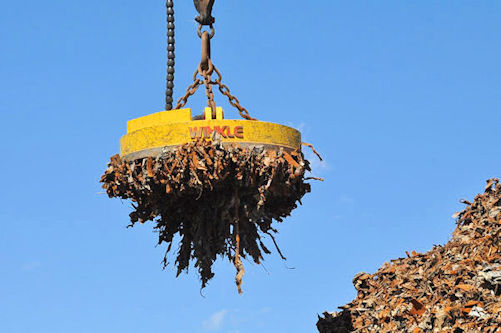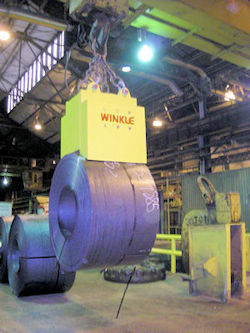Mark Volansky of Winkle Industries answers five commonly asked questions about lifting magnets.
1) Is there an advantage in a cast magnet versus a fabricated magnet?
There are two schools of thought. Each has its advantages. A cast magnet is a case made in a single piece, often with a ribbed exterior for strength and durability. However, in many instances, it is not as repairable as a fabricated magnet. In a fabricated magnet, the individual components of the magnet are welded together to form a very strong, mechanically sound piece of equipment. If the magnet needs to be repaired, the individual components can be replaced, thereby keeping the repair costs down.
2) Which is better, an aluminum-wound magnet or copper-wound magnet
Aluminum-wound magnets are much more accepted in the scrap industry. They are lighter, less expensive than copper-wound magnets and a better option for hydraulic cranes. A copper-wound magnet is best utilized for a severe application, such as a slag or drop ball.
3) What are the key factors that affect lift capacity?
A scrap magnet’s lift capacity is determined by the ampere/turns in the coil, as well as the surface area of the bottom of the magnet. The number of amps times the number of turns generates the magnetic field. The greater bottom surface area allows for a larger magnetic field to be generated, thereby creating a greater lift. The caution here is related to air-gap. The denser the material with less air-gap, the better the lift capability of the magnet.
4) Does the size of the pole shoes on a magnet affect lift capacity?
Absolutely. The magnetic field produced by a magnet coil needs the proper amount of steel section in not only the center pole shoe and outer pole shoe but in other areas of the magnet to force the magnetic flux down to the scrap being
lifted. If the pole shoes are not properly designed to allow for maximum flux density, the lift of a magnet will be negatively affected.
5) How often should magnets be inspected?
They should be visually inspected at the beginning of every shift for obvious mechanical damage. The leads and connectors should also be inspected. A damaged lead or connector could lead to a short in the magnet necessitating a rebuild.
More info: Winkleindustries.com
About the Author: Mark Volansky is Director of Sales at Winkle Industries, Alliance Ohio. He can be reached at 1-800-771-3321.


